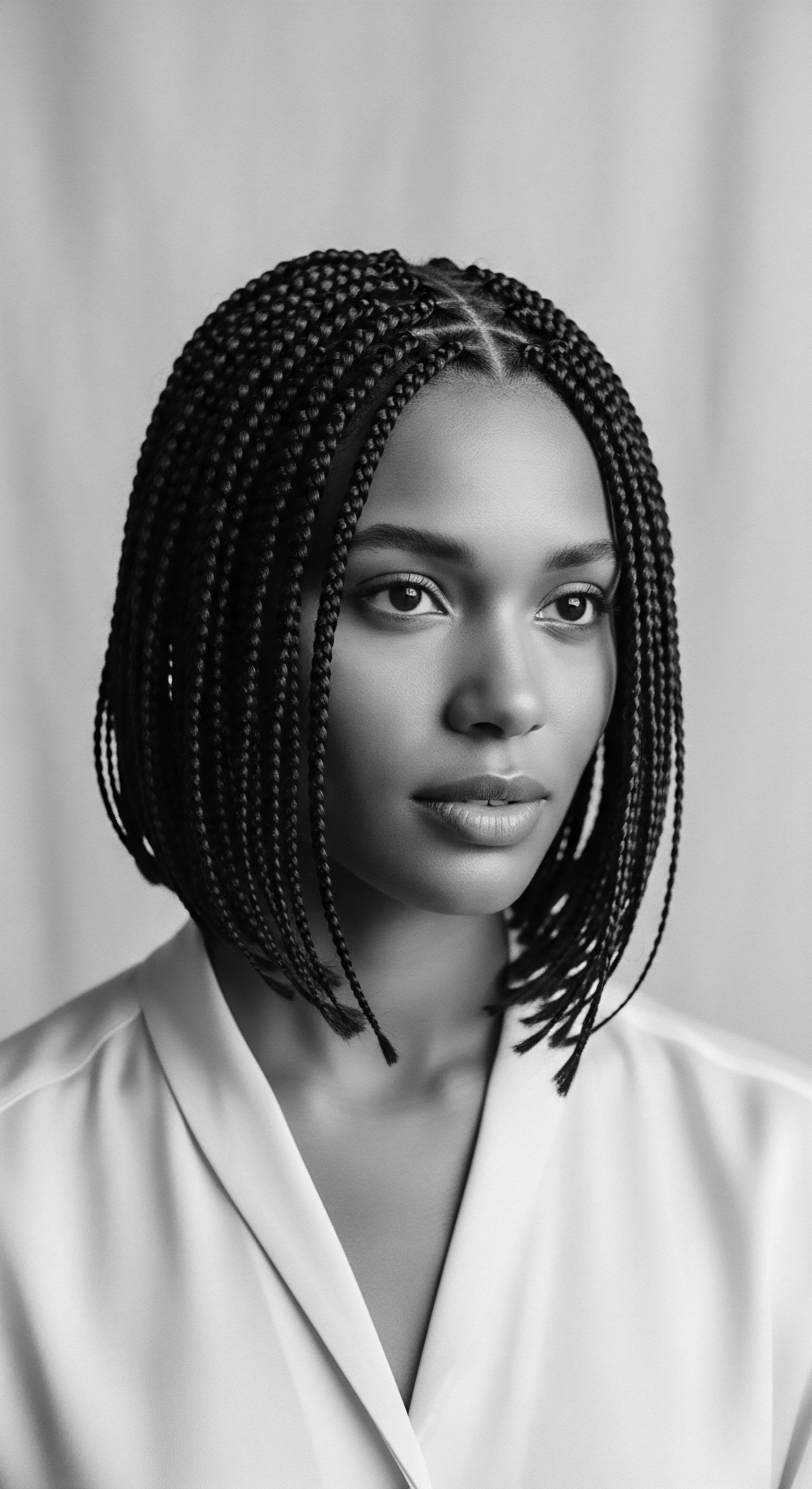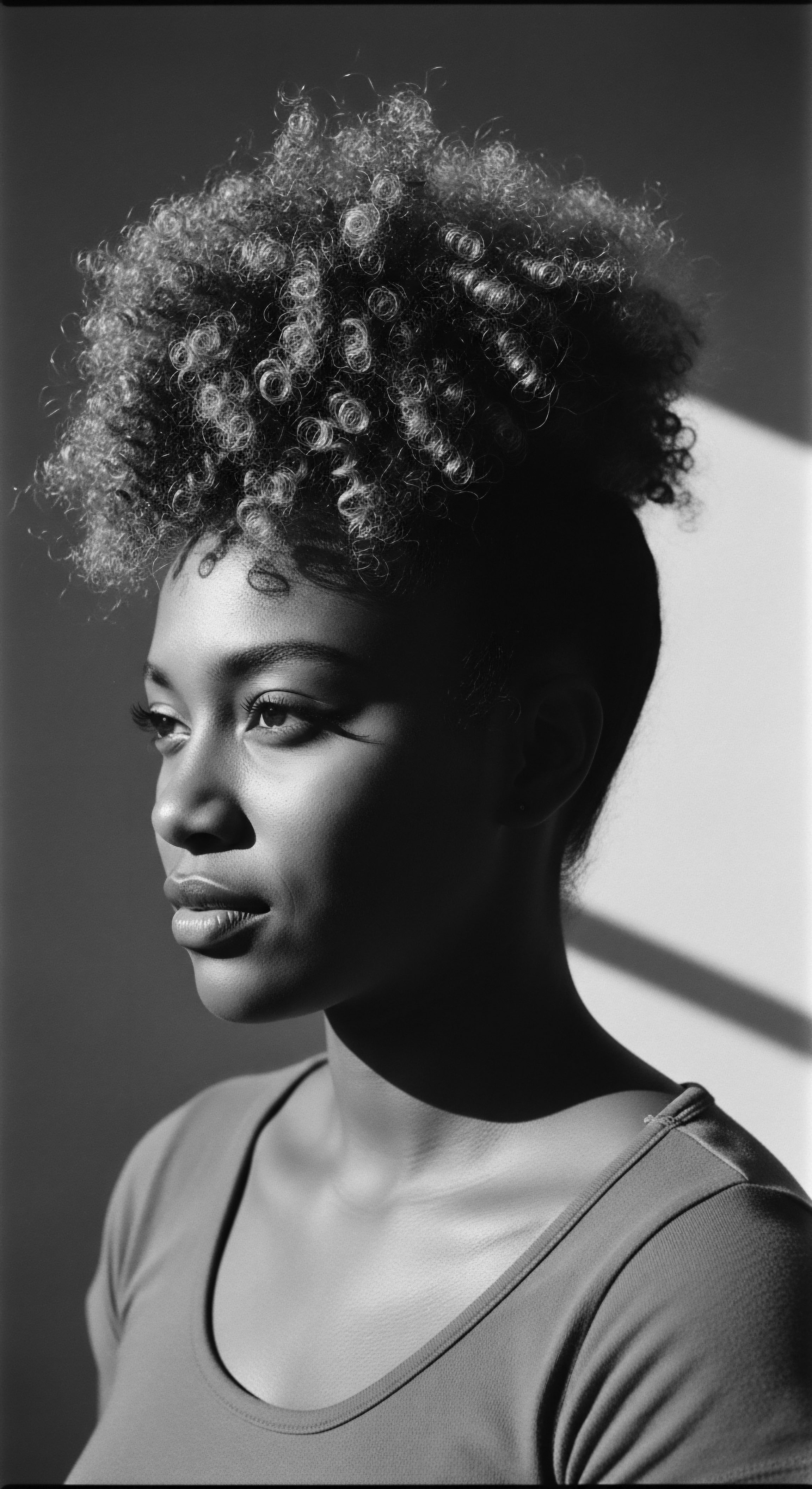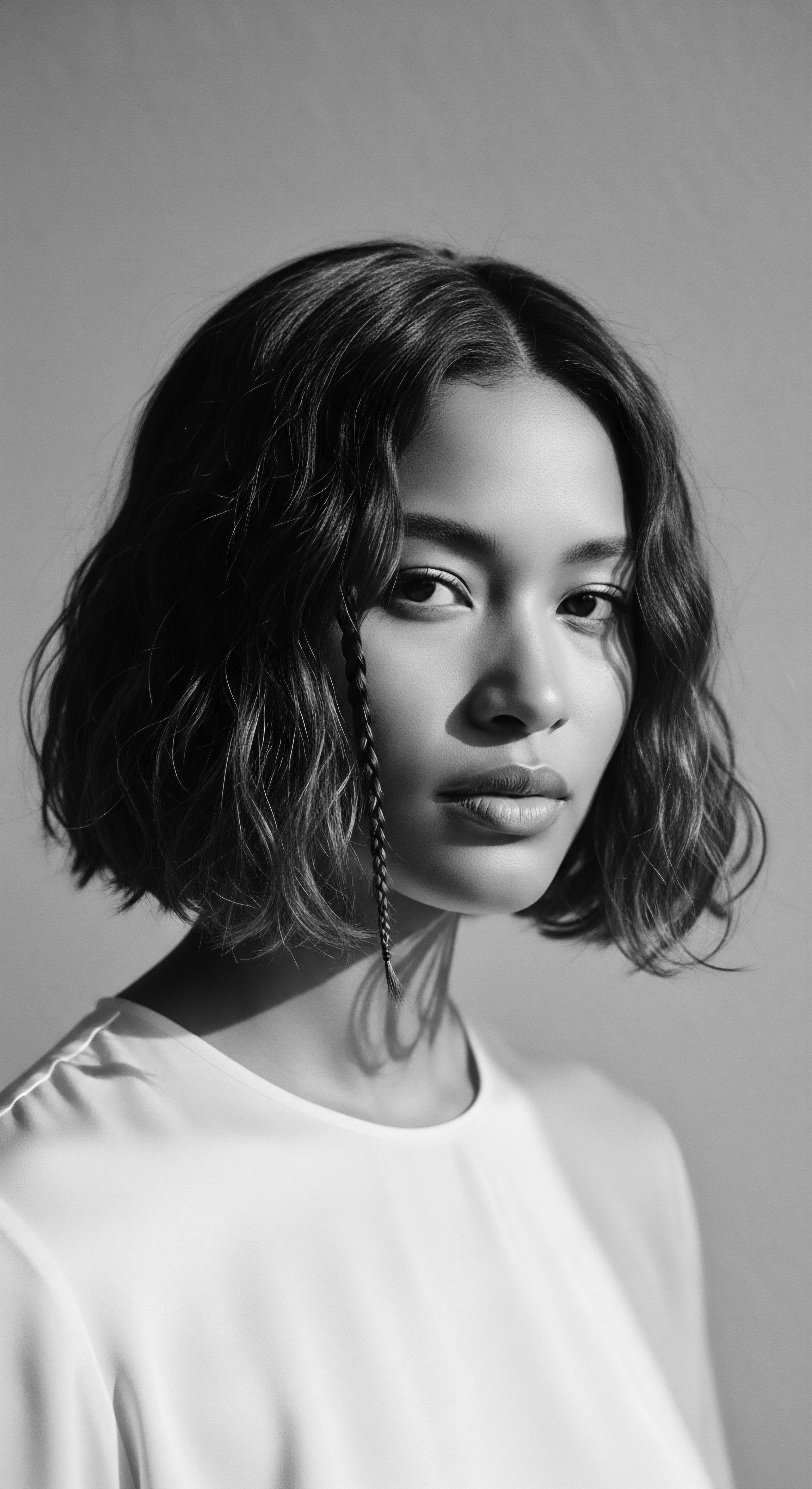
Fundamentals
Hair Regimens, at its most elemental delineation, refers to the systematic and intentional approach one undertakes for the care and preservation of their hair. This is not merely a collection of disparate actions, but a cohesive sequence of practices, thoughtfully chosen and consistently applied, designed to foster the vitality of the strands and scalp. The fundamental meaning of this term, however, extends far beyond simple cosmetic application; it embodies a deeper commitment to the well-being of one’s crown, a practice echoing through the corridors of time, particularly within the heritage of textured hair.
Across various cultures, the concept of a Hair Regimens has always been intertwined with the rhythms of daily life and the wisdom passed down through generations. From ancient civilizations, the careful tending of hair represented health, social standing, and spiritual connection. The designation of specific days for washing, oiling, or styling, often using ingredients gathered from the earth, formed an intrinsic part of ancestral routines. These practices, though seemingly simple, laid the groundwork for the more complex Hair Regimens we recognize today.
A Hair Regimens, at its heart, is a deliberate dance of care, a legacy inherited from those who honored their hair as a sacred extension of self and community.
The elucidation of Hair Regimens for textured hair types, including Black and mixed-race hair, holds a special significance. These hair textures, with their unique curl patterns, coil formations, and inherent dryness, demand a particular understanding and a bespoke approach to care. The practices involved are not merely about aesthetics; they are about nurturing a hair type that has often been misunderstood or marginalized in dominant beauty narratives. This intentionality, a profound sense of purpose, ensures that each strand receives the attention it requires to flourish.

The Genesis of Care
In tracing the genesis of Hair Regimens, we discover echoes from the source, resonating with the earliest forms of human adornment and self-care. Before the advent of modern products, people relied on the bounty of their natural environments. Leaves, barks, roots, and oils were meticulously prepared and applied, not just for cleansing, but for their purported healing and protective properties. The specification of these early rituals speaks to an intuitive understanding of hair’s needs, long before scientific laboratories could dissect its molecular structure.
- Cleansing Rituals ❉ Early communities used natural soaps derived from plants, or cleansing clays, to purify the scalp and hair, often followed by rinsing with herb-infused waters.
- Nourishing Treatments ❉ Plant-based oils, such as shea butter or palm oil, were regularly massaged into the scalp and strands to provide moisture and promote strength.
- Protective Styles ❉ Braiding, twisting, and knotting hair served not only as adornment but also as a means to shield hair from environmental elements and mechanical damage.

Daily Rhythms of Ancestry
The historical interpretation of Hair Regimens reveals that these were not isolated events but rather consistent rhythms within the daily or weekly routines of individuals and communities. The tender application of natural butters, the patient sectioning for intricate braiding, or the communal gathering for shared grooming sessions all formed part of a living library of hair care. These ancestral practices, often imbued with spiritual or social meaning, underscored the hair’s role as a vital component of personal and collective identity.
For many, the hair was a conduit to the divine, a crown that connected them to their lineage and the spiritual realm. The methods of care, therefore, carried a sacred import, transforming a mundane task into a ritual of reverence. This historical context illuminates the profound value and intention embedded within the very notion of a Hair Regimens, a substance that transcends mere routine to become an act of deep self-respect and cultural affirmation.
| Aspect of Care Cleansing Agents |
| Ancestral Practice (Pre-Colonial Africa) Plant-derived soaps, clays, ash-based washes. |
| Contemporary Parallel (Textured Hair Regimens) Sulfate-free shampoos, co-washes, bentonite clay masks. |
| Aspect of Care Moisturizers & Sealants |
| Ancestral Practice (Pre-Colonial Africa) Shea butter, cocoa butter, palm oil, plant oils. |
| Contemporary Parallel (Textured Hair Regimens) Leave-in conditioners, hair milks, natural oils (jojoba, argan, coconut). |
| Aspect of Care Styling & Protection |
| Ancestral Practice (Pre-Colonial Africa) Intricate braids, twists, knots, headwraps. |
| Contemporary Parallel (Textured Hair Regimens) Box braids, twists, Bantu knots, wigs, satin bonnets. |
| Aspect of Care The fundamental components of hair care have persisted through time, adapting to new contexts while retaining their core purpose of nurturing textured hair. |

Intermediate
Moving beyond the foundational explication, the Hair Regimens blossoms into a more intricate design, a personalized symphony of care composed for the unique cadences of each strand. The intermediate meaning of a Hair Regimens recognizes that while core principles remain constant, their application varies significantly depending on the specific characteristics of one’s hair. This is particularly true for textured hair, where variations in curl pattern, porosity, and density demand a nuanced approach to care, a testament to the diverse expressions of hair heritage.
The understanding of Hair Regimens at this level involves a deeper discernment of the hair’s biological needs and how ancestral wisdom often provided intuitive solutions to these requirements. The recognition of hair as a living entity, capable of expressing its condition through its feel and appearance, guides the selection of products and techniques. This perspective allows for a more responsive and adaptive care routine, moving beyond rigid rules to embrace the dynamic relationship between hair and its caretaker.
An intermediate Hair Regimens represents a responsive dialogue between individual hair needs and the collective wisdom of care traditions.

Decoding the Strand’s Whisper
To craft an effective Hair Regimens for textured hair, one must first learn to decode the whispers of the strand itself. Textured hair, ranging from loose waves to tightly coiled patterns, possesses inherent structural differences that influence its hydration levels and susceptibility to breakage. The elliptical shape of the hair follicle in textured hair causes the strand to curl as it grows, making it more challenging for natural oils from the scalp to travel down the hair shaft, often leading to dryness.
Understanding the significance of porosity—the hair’s ability to absorb and retain moisture—becomes a central tenet of this more advanced comprehension of Hair Regimens. Hair with high porosity readily absorbs water but struggles to hold onto it, while low porosity hair resists moisture penetration but retains it once absorbed. Tailoring a Hair Regimens to these specific needs, selecting ingredients that either seal moisture within or facilitate its entry, represents a sophisticated application of care principles.
Historically, ancestral communities intuitively grasped these distinctions, even without modern scientific terminology. They observed how certain plant oils sealed moisture effectively for some hair types, while others required more frequent application of water-based concoctions. This empirical knowledge, passed down through oral traditions and communal practices, formed the basis of their Hair Regimens, demonstrating a profound understanding of hair’s varied requirements.

The Rites of Restoration
The implementation of a Hair Regimens for textured hair often prioritizes moisture retention and protective styling, reflecting a long history of practices designed to preserve the integrity of these delicate strands. The meaning of “protective styling” transcends mere aesthetics; it is a strategic measure to shield hair from environmental aggressors, reduce manipulation, and minimize breakage. This tradition of protection dates back centuries, with ancestral communities utilizing braids, twists, and headwraps not only for adornment but also for the preservation of hair health.
A typical intermediate Hair Regimens might include ❉
- Pre-Poo Treatments ❉ Applying oils or conditioners before shampooing helps to protect hair from excessive stripping of natural oils during the cleansing process.
- Gentle Cleansing ❉ Opting for sulfate-free shampoos or co-washes minimizes dryness, preserving the hair’s delicate moisture balance.
- Deep Conditioning ❉ Regular deep conditioning treatments infuse hair with vital moisture and nutrients, enhancing elasticity and strength.
- Leave-In Application ❉ Following cleansing and conditioning, leave-in products provide ongoing hydration and a protective layer.
- Sealing Moisture ❉ Applying oils or butters after water-based products helps to lock in hydration, especially crucial for high porosity hair.
- Protective Styling ❉ Incorporating styles like braids, twists, or buns reduces daily manipulation and exposure, fostering length retention.

Generational Wisdom in Practice
The ongoing practice of Hair Regimens for textured hair is a living testament to generational wisdom. From the meticulous care of hair in ancient African societies, where hair communicated social status, age, and spiritual beliefs, to the resilience displayed in the diaspora, these regimens represent continuity. The tools and ingredients may have evolved, yet the core principles of nurturing, protecting, and honoring textured hair remain steadfast.
For instance, the use of various plant-based ingredients in traditional African hair care finds modern resonance in the popularity of natural oils and butters in contemporary regimens. Shea butter, a staple in West African communities for centuries, is now a globally recognized ingredient for its moisturizing properties, validating ancestral knowledge through modern scientific understanding. This connection between past and present highlights the enduring efficacy of these time-honored practices, demonstrating that the profound understanding of hair care is a continuous thread woven through generations.
| Traditional Ingredient/Practice Shea Butter (Oori) |
| Source/Cultural Context West Africa (e.g. Epe communities, Nigeria). |
| Modern Hair Regimen Equivalent/Benefit Deep conditioner, sealant, moisturizer for dry, textured hair. |
| Traditional Ingredient/Practice Palm Oil |
| Source/Cultural Context Various African communities. |
| Modern Hair Regimen Equivalent/Benefit Emollient in conditioners, promoting shine and softness. |
| Traditional Ingredient/Practice Henna (Lawsonia inermis) |
| Source/Cultural Context North Africa, Middle East, South Asia. |
| Modern Hair Regimen Equivalent/Benefit Natural hair dye, strengthening treatment, scalp conditioner. |
| Traditional Ingredient/Practice Aloe Vera |
| Source/Cultural Context Ancient Egypt, various African cultures. |
| Modern Hair Regimen Equivalent/Benefit Soothing scalp treatment, hydrating agent in gels and leave-ins. |
| Traditional Ingredient/Practice Ancestral ingredients continue to form the backbone of effective Hair Regimens for textured hair, underscoring a timeless connection to nature's remedies. |

Academic
The Hair Regimens, viewed through an academic lens, constitutes a complex interplay of biological understanding, socio-cultural constructs, and ancestral epistemologies, coalescing into a deliberate framework for the maintenance and enhancement of hair’s physiological integrity and symbolic meaning. This academic definition transcends a mere list of products or steps, instead offering a profound analysis of the systemic care of hair as a reflection of human agency, cultural resilience, and scientific inquiry. It recognizes that for textured hair, particularly within Black and mixed-race communities, the Hair Regimens is not simply a personal grooming routine; it is a historically charged, culturally rich, and often politically significant practice.
The elucidation of Hair Regimens at this advanced level demands an exploration of its multifaceted dimensions, acknowledging how historical oppression, societal beauty standards, and ongoing movements for self-acceptance have shaped its evolution. This requires a rigorous examination of both the intrinsic properties of textured hair and the extrinsic forces that have influenced its care, styling, and perception across generations. The meaning here is not static; it is a dynamic concept, constantly redefined by lived experiences and scholarly investigation.

An Archeology of Hair Care
An archeological examination of Hair Regimens reveals that sophisticated hair care practices existed in African societies long before the transatlantic slave trade. Hair was a powerful visual marker, conveying information about one’s age, marital status, tribal affiliation, wealth, and spiritual standing. Specific hairstyles and the meticulous care required to maintain them were integral to these communicative functions.
For instance, in many West African cultures, intricate braiding patterns were not only aesthetic but also served as a form of visual language, telling stories or indicating social roles. The practice of applying natural oils, herbs, and clays was deeply embedded in these societies, forming systematic approaches to hair health that aligned with cultural beliefs and community bonds.
The imposition of slavery, however, represented a brutal rupture in these ancestral Hair Regimens. Enslaved Africans were often stripped of their hair tools and forced to shave their heads, a deliberate act of dehumanization aimed at severing their connection to identity and culture. This systematic assault on hair and its associated care practices was a foundational trauma, forcing ingenuity and adaptation in the face of immense adversity.
Despite these efforts to erase heritage, enslaved people found clandestine ways to maintain aspects of their Hair Regimens, using what limited resources were available, such as axle grease or bacon fat, to condition their hair, or secretly braiding patterns that conveyed hidden messages or maps for escape. This resilience speaks to the inherent value placed on hair, even under the most oppressive conditions.

The Societal Helix ❉ Hair as Cultural Marker and Site of Resistance
The Hair Regimens, particularly for Black women, became a site of profound socio-political struggle and resistance in the diaspora. Following emancipation, and well into the 20th century, Eurocentric beauty standards gained dominance, pressuring Black individuals to conform by straightening their textured hair. This societal pressure led to the widespread use of chemical relaxers and hot combs, often at significant cost to hair health and personal identity. The desire for “good hair,” often synonymous with straight hair, reflected an internalized racism that devalued natural textures.
A compelling historical example of this tension and resistance is the implementation of the Tignon Laws in Spanish colonial Louisiana in 1786. Governor Esteban Rodríguez Miró issued a decree mandating that free women of color wear a tignon, a headscarf, to cover their hair when in public. The intention behind this law was explicitly to distinguish these women from white women, particularly as their elaborate and adorned hairstyles were seen as a threat to the established social hierarchy and attracted white suitors. This legal imposition directly targeted the Hair Regimens of free Black women, aiming to suppress their visible displays of beauty, status, and self-expression through their hair.
The Tignon Laws, a historical decree forcing Black women to cover their hair, paradoxically transformed a symbol of oppression into a vibrant statement of defiance and cultural pride.
Yet, the response of these women was a powerful act of defiance. Instead of allowing the tignon to diminish their presence, they transformed it into a statement of unparalleled style and creativity. They adorned their headwraps with luxurious fabrics, vibrant colors, and intricate knots, often incorporating feathers and jewels, making the tignon itself a mark of distinction, wealth, and undeniable beauty. This historical instance illustrates how a seemingly simple aspect of a Hair Regimens—hair covering—could become a potent vehicle for asserting identity and resisting oppressive norms.
The meaning of the tignon shifted from a tool of subjugation to a symbol of ingenuity and cultural pride, demonstrating the profound resilience embedded within the Hair Regimens of Black communities. This historical narrative underscores how hair, and its associated care practices, is inextricably linked to broader societal narratives of race, power, and identity.

Biochemical Choreography of the Strand
From a biochemical perspective, the Hair Regimens involves a sophisticated understanding of the unique physiological characteristics of textured hair. The distinct helical structure of textured hair, characterized by its tighter curl patterns and often flatter, elliptical follicle shape, influences its mechanical properties and moisture dynamics. This structure results in fewer cuticle layers and a more exposed cortex at the curves of the strand, rendering it more susceptible to breakage and dryness compared to straighter hair types.
The Hair Regimens, therefore, must account for these inherent vulnerabilities. Scientific studies validate the ancestral emphasis on moisture retention for textured hair. The natural sebum produced by the scalp struggles to travel down the spiraled length of coiled strands, leading to chronic dryness.
This dryness, in turn, reduces elasticity, making the hair more prone to tangling and breakage during manipulation. Consequently, effective Hair Regimens prioritize hydration through emollients, humectants, and occlusives, often drawing from traditional ingredients like shea butter and various plant oils, whose efficacy is now supported by modern cosmetic science.
The explication of product chemistry within a Hair Regimens focuses on ingredients that cater to the specific needs of textured hair ❉
- Humectants ❉ Ingredients such as glycerin or honey draw moisture from the air into the hair shaft, providing hydration.
- Emollients ❉ Oils and butters, including ancestral staples like coconut oil or cocoa butter, soften the hair and smooth the cuticle.
- Proteins ❉ Hydrolyzed proteins can temporarily strengthen the hair shaft, reducing breakage, particularly important for chemically treated or damaged textured hair.
- Surfactants ❉ Gentle, sulfate-free cleansing agents preserve natural oils while effectively removing buildup, a practice echoing the mild plant-based cleansers of antiquity.

The Psychosocial Tapestry ❉ Identity and Self-Acceptance
The psychosocial dimension of Hair Regimens for textured hair cannot be overstated. The historical pressures to conform to Eurocentric beauty ideals created a complex relationship with natural hair, often leading to feelings of shame or inadequacy. The act of engaging in a Hair Regimens, particularly one that celebrates and maintains natural texture, becomes a powerful statement of self-acceptance and cultural pride. This reclamation of natural hair is a contemporary echo of ancestral reverence for hair as a sacred part of identity.
The decision to embrace a natural Hair Regimens is often a deeply personal yet profoundly communal experience, fostering connections within the Black and mixed-race hair communities. Online platforms and social gatherings dedicated to natural hair care serve as spaces for sharing knowledge, celebrating diverse textures, and offering mutual support. This collective engagement reinforces the understanding that a Hair Regimens is not merely a set of instructions but a living, breathing expression of cultural heritage and individual journey. The psychological impact of this self-affirmation contributes significantly to holistic well-being, transforming hair care from a chore into a ritual of empowerment.
| Historical Period/Context Pre-Colonial Africa |
| Hair Regimen Practices & Perception Intricate styles, natural ingredients, communal grooming. Hair signifies status, spirituality, identity. |
| Societal Impact & Significance Hair as a respected cultural marker, symbol of beauty and community cohesion. |
| Historical Period/Context Slavery & Post-Emancipation |
| Hair Regimen Practices & Perception Forced shaving, limited resources, improvised care (e.g. axle grease). Pressure to straighten hair. |
| Societal Impact & Significance Dehumanization, loss of cultural connection, emergence of "good" vs. "bad" hair hierarchy. |
| Historical Period/Context Civil Rights Era (Mid-20th Century) |
| Hair Regimen Practices & Perception Rise of the Afro, rejection of chemical straightening. |
| Societal Impact & Significance Hair as a political statement, symbol of Black power, pride, and resistance. |
| Historical Period/Context Natural Hair Movement (21st Century) |
| Hair Regimen Practices & Perception Embracing natural textures, focus on moisture, protective styling, specialized products. |
| Societal Impact & Significance Reclamation of heritage, self-acceptance, growth of Black hair care industry, challenging Eurocentric norms. |
| Historical Period/Context The Hair Regimens for textured hair reflects a continuous narrative of adaptation, resilience, and profound cultural assertion against shifting societal landscapes. |

Reflection on the Heritage of Hair Regimens
The Hair Regimens, as we have explored its various layers of interpretation, stands as a profound meditation on the enduring spirit of textured hair and its indelible connection to heritage. It is more than a mere collection of steps or products; it is a living, breathing archive of ancestral wisdom, a testament to resilience, and a vibrant expression of identity. From the elemental biology that shapes each unique curl to the ancient practices passed down through generations, and finally, to its role in voicing identity and shaping futures, the Hair Regimens is a journey, not a destination.
This exploration reminds us that every strand carries a story, a memory of hands that nurtured, of communities that celebrated, and of spirits that resisted. The gentle touch of oil, the careful sectioning of braids, the patience required for growth—these actions are echoes from the source, rituals that link us to those who walked before us. They are the tender threads that bind us to a legacy of care, a deep reverence for the crown that sits upon our heads.
As we look forward, the Hair Regimens continues to evolve, yet its core remains rooted in this rich past. The unbound helix of textured hair, with its inherent beauty and strength, calls upon us to honor its unique needs, to understand its historical journey, and to celebrate its cultural significance. This ongoing dialogue between ancestral wisdom and contemporary understanding allows us to approach hair care not as a burden, but as a joyful affirmation of who we are and where we come from. The future of Hair Regimens for textured hair is one of continued discovery, profound respect, and unwavering celebration of every coil, curl, and wave.

References
- Byrd, A. & Tharps, L. L. (2001). Hair Story ❉ Untangling the Roots of Black Hair in America. St. Martin’s Press.
- Wong, N. Williams, K. Tolliver, S. & Potts, G. (2025). Historical Perspectives on Hair Care and Common Styling Practices in Black Women. Cutis, 115(3), 95-98.
- Banks, I. (2000). Hair Matters ❉ Beauty, Power, and Black Woman’s Consciousness. New York University Press.
- Omotos, A. (2018). The Significance of Hair in Ancient African Civilizations. Journal of Pan African Studies, 11(6), 1-15.
- Mbilishaka, A. (2018). PsychoHairapy ❉ Brushing Up on the History and Psychology of Black Hair. Psi Chi Journal of Psychological Research, 23(4), 312-320.
- Tharps, L. L. & Byrd, A. D. (2014). Hair Story ❉ Untangling the Roots of Black Hair in America. St. Martin’s Griffin.
- Tate, S. (2007). Black Women’s Bodies and the Nation ❉ Race, Gender and Culture. Palgrave Macmillan.
- Jacobs-Huey, L. (2007). Black Women and Identity ❉ What’s Hair Got to Do With It?. University of Michigan.
- Sharaibi, O. J. Oluwa, O. K. Omolokun, K. T. Ogbe, A. A. & Adebayo, O. A. (2024). Cosmetic Ethnobotany Used by Tribal Women in Epe Communities of Lagos State, Nigeria. Journal of Complementary Medicine & Alternative Healthcare, 12(4), 555845.
- Rmane, M. El Ghoumari, M. & Khalki, Y. (2018). Ethnobotanical Survey of Medicinal Plants used in the Treatment and Care of Hair in Karia ba Mohamed (Northern Morocco). International Journal of Botany Studies, 3(4), 18-24.
